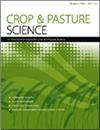Legume persistence for grasslands in tableland environments of south-eastern Australia
IF 1.9
4区 农林科学
Q2 AGRICULTURE, MULTIDISCIPLINARY
引用次数: 4
Abstract
ABSTRACT Context. Improving the stability of legumes in grasslands in the face of variable seasonal conditions is key to mitigating risks posed by drought. Aims. We assessed the persistence of a range of legume species and cultivars in order to inform legume choice for pasture improvement and identify priority species for further development. Methods. Twenty field experiments in four series were conducted at sites with contrasting seasonal and soil characteristics in the ‘high-rainfall’ (560–920 mm long-term average) Tablelands and Monaro regions of New South Wales, Australia. Legumes were grown as pure swards and assessed periodically for seedling density, plant frequency and dry matter for up to 5 years. Key results. Legume dry matter production was positively correlated with plant frequency. However, most legumes persisted poorly at most sites, particularly on soils of lower fertility. Subterranean clover (Trifolium subterraneum) cv. Goulburn was the best performing cultivar of that species across sites on the Southern Tablelands and Monaro. Yellow serradella (Ornithopus compressus) cvv. Avila and Yellotas showed promising persistence, particularly under drought conditions. White clover (T. repens) was the most broadly adapted of the perennial legumes across a range of soils, but persistence was still inadequate at many sites. Lucerne (Medicago sativa) was approximately twice as productive as the next-most productive species when soil conditions suited its growth, but it failed to persist on acidic, low-fertility soils. Conclusions. Serradella species (yellow and French, O. sativus) and white clover, in conjunction with subterranean clover, offer the best near-term prospects for diversifying legume productivity and resilience under variable seasonal conditions in tableland environments. Implications. An increased focus on phenology and seed characteristics is suggested to improve the persistence of annual and facultative perennial legume species in grasslands. Serradella and white clover are identified as the highest priorities for cultivar development for tableland environments of south-eastern Australia.澳大利亚东南部高原环境中豆科植物对草地的持久性
摘要上下文。面对多变的季节条件,提高草原上豆类的稳定性是减轻干旱风险的关键。目标。我们评估了一系列豆类物种和品种的持久性,以便为牧场改良的豆类选择提供信息,并确定进一步发展的优先物种。方法。在澳大利亚新南威尔士州的“高降雨量”(560–920毫米长期平均值)高原和莫纳罗地区,在具有对比季节和土壤特征的地点进行了四个系列的20个田间试验。豆类作为纯草皮种植,并在长达5年的时间内定期评估幼苗密度、植株频率和干物质。关键成果。豆类干物质产量与植株频率呈正相关。然而,大多数豆科植物在大多数地点的存活率很低,尤其是在肥力较低的土壤上。地下三叶草(Trifolium subterraneum)cv.Goulburn是该物种在南部高原和莫纳罗地区表现最好的品种。黄色serradella(Ornithopus compressus)cvv。Avila和Yellotas表现出有希望的持久性,特别是在干旱条件下。白三叶草(T.repens)是一系列土壤中最广泛适应的多年生豆科植物,但在许多地方仍然不够持久。当土壤条件适合其生长时,苜蓿(Medicago sativa)的生产力大约是第二高生产力物种的两倍,但它未能在酸性、低肥力土壤中持续存在。结论。Serradella物种(黄色和法国,O.sativus)和白三叶草,以及地下三叶草,在高原环境中的可变季节条件下,为豆类生产力和恢复力的多样化提供了最佳的近期前景。含义。建议更多地关注酚学和种子特性,以提高一年生和兼性多年生豆科植物在草原上的持久性。塞拉德拉和白三叶草被确定为澳大利亚东南部高原环境下品种开发的最高优先事项。
本文章由计算机程序翻译,如有差异,请以英文原文为准。
求助全文
约1分钟内获得全文
求助全文
来源期刊

Crop & Pasture Science
AGRICULTURE, MULTIDISCIPLINARY-
CiteScore
4.20
自引率
15.80%
发文量
111
审稿时长
3 months
期刊介绍:
Crop and Pasture Science (formerly known as Australian Journal of Agricultural Research) is an international journal publishing outcomes of strategic research in crop and pasture sciences and the sustainability of farming systems. The primary focus is broad-scale cereals, grain legumes, oilseeds and pastures. Articles are encouraged that advance understanding in plant-based agricultural systems through the use of well-defined and original aims designed to test a hypothesis, innovative and rigorous experimental design, and strong interpretation. The journal embraces experimental approaches from molecular level to whole systems, and the research must present novel findings and progress the science of agriculture.
Crop and Pasture Science is read by agricultural scientists and plant biologists, industry, administrators, policy-makers, and others with an interest in the challenges and opportunities facing world agricultural production.
Crop and Pasture Science is published with the endorsement of the Commonwealth Scientific and Industrial Research Organisation (CSIRO) and the Australian Academy of Science.
 求助内容:
求助内容: 应助结果提醒方式:
应助结果提醒方式:


